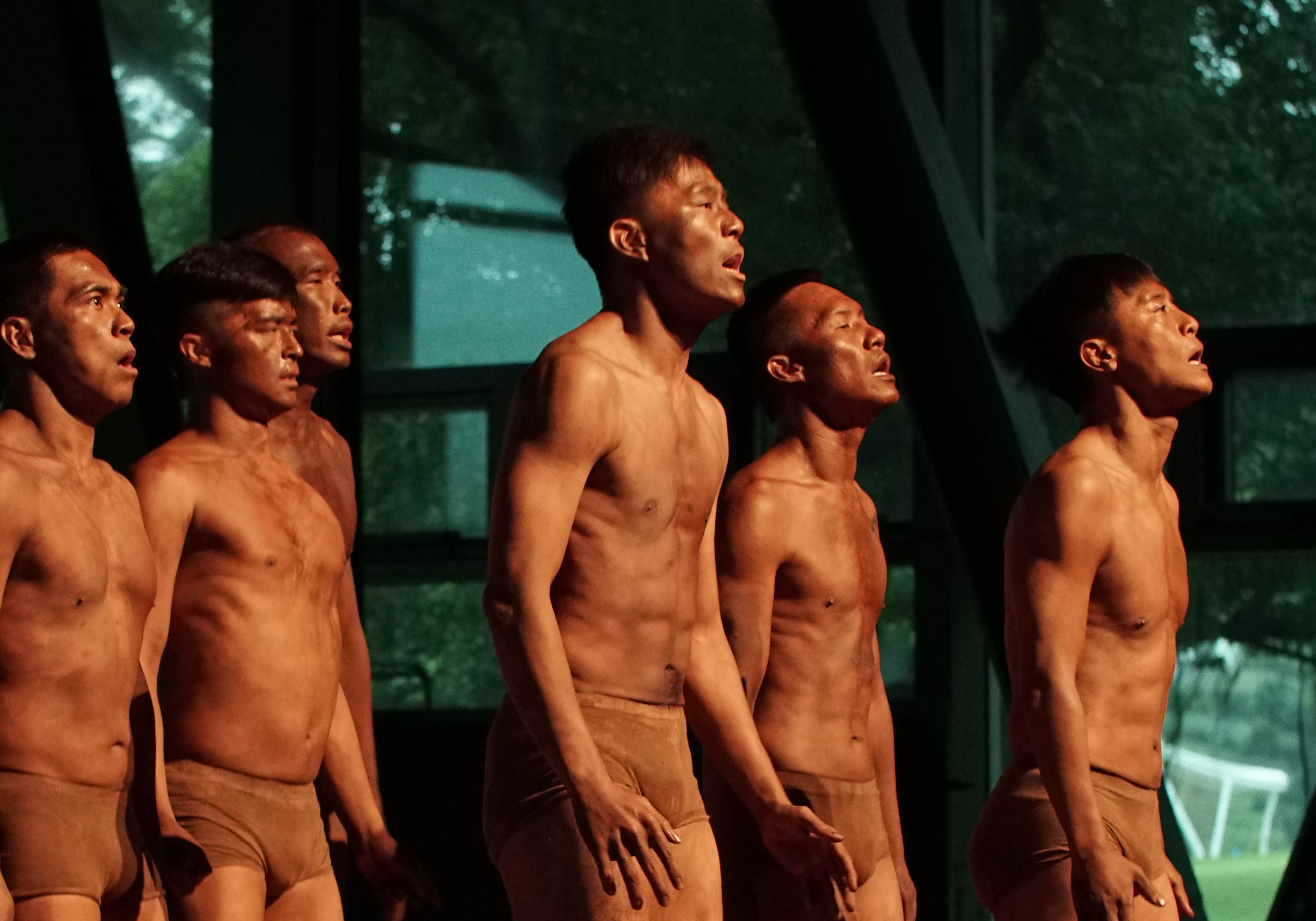1993年,編舞家布拉瑞揚在雲門舞作《九歌》裡聽見Senayan(賴秀珍)、Muagai(柯梅英)、Ivi(卓秀琴)演唱卑南族南王部落婦女吟唱,就被震憾住了。直到2011年,他陸續認識這「三位天后」,終於在2017年以《無,或就以沈醉為名》一償宿願。
26年後的再交鋒,三種聲音、三種風景,穿透空間、穿透時間,穿透語言與文化,帶我們尋找靈魂的原鄉。布拉瑞揚選擇以「一人一故事劇場」的方式,試圖讓觀者進入三位的生命史,從「同理心」的被建構,拉近了陌生群體對主體的關注,「沒有人是局外人」的意識型態,也能更快的滲入所有觀者。
舞者與歌者的互動,揭示了原民生活的種種悲歌,包括當時正在凱道發生的驅離事件。《無,或就以沈醉為名》看似讓你笑,卻同時也讓人心酸,內裡是中和了兩者的苦。布拉瑞揚用虔誠的生活態度,帶入後勁強而具省思的抵制霸權行動。
Choreographer Bulareyaung Pagarlava was awestruck upon hearing a vocal performance by Senayan, Muagai and Ivi from the Sakuban Village of the Puyuma tribe at the Cloud Gate Dance Company performance Nine Songs in 1993. He was able to meet each of these “three divas” by 2011, and realized a long-held ambition with Stay that Way in 2017.
The work includes three voices, three landscapes, which transcend time and space, and language and culture, bringing us to search the soul’s source of origin. Bulareyaung chooses the ”one person, one tale theater” in an attempt to introduce the audience to the life history of the three individuals. With “empathy” as a point of construction, he allows the audience to deeply care about the subject matter. The ideology of “no one is an outsider” rapidly envelopes the viewer.
The interaction between dancer and singer reveals the various sad songs in the lives of indigenous people, including the forced dispersion from Ketagalan Blvd. that was occurring concurrent to the performance. Stay That Way will make you laugh, but also tugs at the heartstrings, mediating the pain between the two. With a sincere attitude toward life, Bulareyaung brings anstrong and contemplative act of resistance against hegemonic power.
布拉瑞揚舞團 The Bulareyaung Dance Company
2014年由排灣族編舞家布拉瑞揚‧帕格勒法創立。身為原住民,「認同」的過程引領他開啟了一段新旅程。他回到家鄉創立舞團,落腳台東舊糖廠倉庫,與十多位極具天分潛力的東部青年舞者工作,在靠山面海的自然環境裡,藉由聲音與身體動作關係的發展,以及文化上的田野調查,深入探究台灣東岸獨特的人文底蘊,發展原住民當代舞蹈的身體表述和語彙。
The Bulareyaung Dance Company was established by Bulareyaung Pagarlava in 2014. As an indigenous person, the process of “identity” led him to begin a new journey. He returned home to establish the dance company which is based in the old warehouse of the Taitung Sugar Factory. In the natural environment by the sea and sheltered by a mountain, over a dozen talented dancers from the eastern region explore the unique cultural essence of Taiwan’s eastern coast, to develop a lexicon and corporeal expression for indigenous contemporary dance by developing sound and body movements, and conducting cultural field research.
布拉瑞揚‧帕格勒法
李建常
鄭捷任
柯梅英 Muagai、賴秀珍 Senayan、卓秋琴 Ivi
周堉睿、許培根 Kevan、曾志浩 Ponay、黃韋捷、 許庭瑋、李奕騏、陳忠仁 Giljigiljaw、郭箏
林定、薛紹君
淡水雲門劇場
關鍵字
藝術家談作品
不以關懷社會為名、不以劇場作品為名。
26年前,編舞家布拉瑞揚在雲門舞作《九歌》裡聽見Senayan(賴秀珍)、Muagai(柯梅英)、Ivi(卓秀琴)演唱卑南族南王部落婦女吟唱,驚為天人。當時,他還在逃避自己的原住民身份,三人的歌聲在他心裡開了一朵小小的花;2011年,布拉瑞揚決定返鄉,卻在因緣際會下陸續認識了「三位天后」,便邀請她們與舞團合演《無,或就以沉醉為名》。
最初,布拉瑞揚只想與觀眾一起分享曾讓他沉醉不已的歌聲,然而凱達格蘭大道的驅離事件,卻讓此舞有了更強烈的關懷。
沒有人是局外人
「無」,也僅「沈醉」;行為與意志先行。
每一位參與的藝術家,都和這塊島嶼共時著,無論凱達格蘭大道或淡水雲門劇場,我們聆聽著這個環境的訊息,陪伴著這塊土地努力。
不以關懷社會為名、不以劇場作品為名。
短短的幾行字,深刻註解了布拉瑞揚對舞作的想法與心情。他說,舞團剛開始排練時,正好遇上「原住民傳統領域劃設辦法」公告,他的好友們紛紛集結到凱達格蘭大道,在寒流雨夜中為自己發聲,而他卻因為演出無法參與。在這期間,他帶著舞者幾次探班,關心著每日的發展,直到凱道強制驅離那天……
「舞者不知道我發生了什麼事,我不斷拿著手機看現場直播,心思都在凱道,根本無法專心排練,最後還哭了……」
首演當天,開演前布拉瑞揚先用沈重的語調,揭示了關於原民生活的種種悲歌,當然包括凱道正在發生的驅離事件。他把凱道上各地原住民或非原住民手繪創作的石頭,都搬到了雲門劇場,要讓大家知道,還有一群人在凱道為台灣拚搏,就算舞團在淡水演出,身心也與他們同在,並且與現場觀眾一起支持他們。
「我們身處在同一個環境裡,沒有人是局外人。」布拉瑞揚說。
快樂的唱悲歌
原本,這支舞作是在戶外進行的。「陽光、草坪、歌聲、舞影,不是很讓人沉醉嗎?」他說,風災之後,舞團已經很習慣在戶外排練了,無論是海邊或山上,甚至雲門的一小片草皮,都能自在地跳起來。然而一場滂沱大雨,逼得他不得不將舞作搬入劇場,反而產生了另一種聚焦的效果。
布拉瑞揚選擇以「一人一故事劇場」的方式,試圖讓觀者進入三位天后的生命史,從「同理心」的被建構,拉近了陌生群體對主體的關注,三種聲音、三種風景,穿透空間、穿透時間,穿透語言與文化,帶我們尋找靈魂的原鄉。「沒有人是局外人」的意識型態,也能更快的滲入所有觀者。
「我們的舞者已經很習慣這種不確定性,他們有足夠的自信,雖然難免緊張,但上了台就是主人。」布拉瑞揚笑著說,不過三位天后卻很擔心,她們要知道走位、要知道台上發生什麼事,等到真正上台了之後,她們才發現原來真的可以做自己,相信舞者、相信空間、相信編舞,這讓布拉瑞揚十分感動。
舞作中,布拉瑞揚著重於部落生活中看似無傷大雅、不經意地嘻鬧的行為中所隱藏或累積的傷害。例如Senayan唱著歌謠,一群男性舞者全臉塗黑,以戲弄的方式騷擾她,一開始她被逗得咯咯笑,連帶著觀眾也跟著笑,但隨著手段愈來愈壓迫,笑聲轉為淚水,現場也變得鴉雀無聲,當男子們離場,只剩下Senayan跪趴在地上,她抹去臉上的淚水,幽幽唱完最後一句歌謠。在這樣一再被打斷的難堪中持續向前進,何嘗不是原住民在歷史與現實中的真實境遇?
撒古流曾說:「快樂的唱悲歌,是原住民很高竿的地方。」《無,或就以沈醉為名》看似讓你笑,卻同時也讓人心酸,內裡是中和了兩者的苦。布拉瑞揚用虔誠的生活態度,帶入後勁強而具省思的抵制霸權行動。
評審談作品
這個作品以獨特的藝術手段回應原住民在台灣政治現實的處境。布拉瑞揚的覺醒與充滿實驗的勇氣,在今日眾聲喧嘩的表演藝術中,格外發人深省。
第16屆 台新藝術獎 表演藝術獎 得獎理由
以偶發的行為破壞舞蹈動作的預設,劇場的當下性與企圖連結天地、場域的整體性,不僅鮮活了舞作,更表達原住民歌、舞、人渾然天成的根源。編舞家擺脫各種流派技巧的影響,回歸原鄉,尋找屬於自己的身體語言與律動,同時卻又創造了與當代既有舞蹈語彙之間的緊張關係,誠實暴露面對舞蹈的矛盾與掙扎。
在返身自我凝視的創作中,這個作品以獨特的藝術手段回應原住民在台灣政治現實的處境。布拉瑞揚的覺醒與充滿實驗的勇氣,在今日眾聲喧嘩的表演藝術中,格外發人深省。
Jury’s Comments for the 16th Performing Arts Award Winner
‘Stay That Way’ employs gestures and situations from daily life to undermine preconceptions about indigenous dance. Its direct theatrical qualities convey dimensions of community life and personal expression, within a cosmology linking sky, earth, and particular location. The production makes palpable the spiritual root of indigenous people’s dance and song. The choreographer’s influences from different dance traditions have fallen away in this work where he establishes his own rhythm and vocabulary, creating a tension between land, body and contemporary dance language.
In this reflexive work, Bulareyaung responds to the realities that indigenous people face with a unique artistic approach. ‘Stay That Way’ embodies self-awakening and courage. Bulareyuang has emerged as a unique voice within the contemporary performing arts.
入圍理由
布拉瑞揚重新出發以來,最為沉重、也最介入現實的作品,揭露在當今看似和平健康、甚至帶了嘉年華意味的新型社運抗爭型態下,那些不曾被理解或被遮蔽的暗面,以及在抗爭過程中,表演、觀看、與參與三種姿態間可能形成的矛盾與弔詭。超越了原住民的角度,對各種認同政治提出迂迴卻犀利的批判。看似即興的安排,卻是步步為營,直指原住民在現實中所遭遇的曲解與歧視。歌者與舞者的表現令人驚豔,整齣舞作結構完整,情緒能量層層堆疊,充滿了實驗創新的勇氣。(主筆/郭強生)
Comments on the finalist artworks
Since his return, this piece is Bulareyaung’s heaviest work that intervenes into the reality in the deepest way. It exposes the dark sides that have never been understood or exposed in new social movements that are seemingly peaceful, healthy, and even somewhat carnivalesque. It also reveals the potential contradictions and paradoxes among the three roles of performer, spectator and participant in the process of demonstration. The work goes beyond the viewpoint of the indigenous people and offers indirect yet a trenchant critique of different identity politics. The arrangement might appear to be spontaneous at first, but is actually the result of an elaborate design, insightfully pointing to the misunderstanding and discrimination faced by indigenous people in real life. The performance by the singers and dancers is remarkable. The structure of the dance is complete and displays rich emotional layers, showing the courage of experiment and innovation. (Commentator: KUO Chiang-Sheng)


.jpg)
.jpg)



